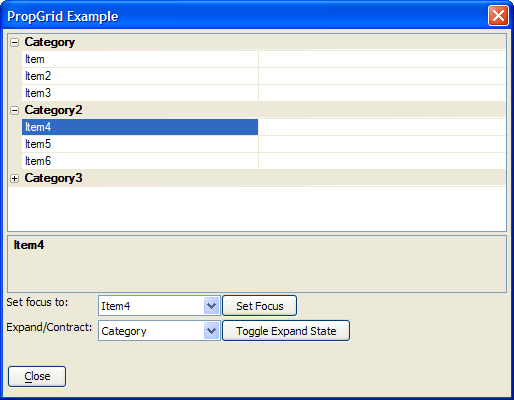{PROPGRID}
Syntax
Arguments
- Width
Numeric. An integer value for the maximum number of characters to display on one line. The actual number displayed may be less because of word wrap.
- Height
Numeric. Optional. Default = 1. The number of rows to display. This may be a fractional number, such as 1.25.
- PropGrid
Pointer. A pointer variable with one of the properties shown below.
Description
The {PROPGRID} command displays the type of control displayed below. The control provides a mechanism for displaying many prompts and accepting many inputs from the user.
PropGrid Properties
.Settings
Pointer
.Def
Character. A CR-LF delimited list of the categories and items in the property grid. Refer to Property Grid Formatting.
.Object
Pointer. Provides access to the Property Grid methods.
Property Grid Formatting
A CR-LF delimited list defines the structure and contents of the property grid. Each entry is on its own line. Entries may:
define the beginning and name of a category
define the state of a category
define the name of an item within a category
define the variable that will contain the user's input
Define a category with the following 2 character sequence at the beginning of a new line "^^". The name of the category follows these 2 characters. For example: ^^CategoryName. The end of a category is defined by the beginning of a new category or the end of the .Def list. Define the open/closed state of a category by placing one of the following two statements immediately after the category definition.
state=opened state=closed
Define the name of an item with the following 2 character sequence at the beginning of a new line "++". The name of the item follows these 2 characters. For example: ++ItemName. Define the variable that will accept the user's input to an item by placing a statement in the following format immediately after the item definition: var= OutputVariable . ItemName. For example:
var=output.Item4
Example
Create the variables for the Property Grid object.
dim pg as P dim pg.settings as P dim pg.def as C dim pg.object as P dim output as P dim output.Item1 as C = "" dim dlg_title as C
Create the variables to display and respond to the list boxes in this example.
dim itemList as C = comma_to_crlf("Item,Item2,Item3,Item4,Item5,Item6,Item7,Item8,Item9")
dim TargetItem as C = "Item"
dim categoryList as C = comma_to_crlf("Category,Category2,Category3")
dim TargetCategory as C = "Category"
dim dlg_title as CDefine the structure of the property grid.
pg.def = <<%str% ^^Category state=opened ++Item var=output.Item1 ++Item2 var=output.Item2 ++Item3 var=output.Item3 ^^Category2 state=closed ++Item4 var=output.Item4 ++Item5 var=output.Item5 ++Item6 var=output.Item6 ^^Category3 state=closed ++Item7 var=output.Item7 ++Item8 var=output.Item8 ++Item9 var=output.Item9 %str%
Define the structure of the property grid.
dlg_title = "PropGrid Example"
ui_modeless_dlg_box(dlg_title,<<%dlg%
{can_exit=close}
{propgrid=100,20pg};
{region}
Set focus to: |.20TargetItem^=itemList;
Expand/Contract: |.20TargetCategory^=categoryList;
{endregion};
{lf};
<10&Close!close>;
%dlg%,<<%code%Respond to events.
if a_dlg_button = "setfocus" then
a_dlg_button = ""
pg.object.SetFocus(TargetItem)
'give focus to the Propgrid object
ui_dlg_ctl_goto(dlg_title,"{propgrid")
else if a_dlg_button = "Toggle"
a_dlg_button = ""
dim currentExpandState as l
currentExpandState = pg.object.IsExpanded(TargetCategory)
pg.object.ExpandItem( TargetCategory, .not. currentExpandState)
else if a_dlg_button = "Close"
a_dlg_button = ""
ui_modeless_dlg_close(dlg_title)
end if
%code%)Properties for a Property Grid Item
- Name
- Description
- var
Name of variable being bound to
- type
Type of control (combo,smart)
- data
Content for special controls (data for combo list if combo, expression for loading the popup).
- help
Help displayed when the item has focus.
- readonly
Expression that determines if user is prevented from editing the item.
- inputbold
When Expression is true, bold the text.
- inputerror
When Expression is true, change the text to red.
- font
Expression returns font descriptor that selects the font to use.
Example Combo
++Color var=v.color type=combo [email protected] help=pick a color
Example Popup (Smart) Field
++Smartfield var=v.text type=smart data=v.text=MyGetFunction(v.text)
Input Bold and Readonly Example
++Smartfield2 var=temp inputbold=v.text<>"" readonly=.t. type=smart data=v.text=MyGetFunction(v.text)
Example of Input Error
++Name var=Name inputerror=name="bad"
Example Font Change
++Name var=name font=if(name="henry","Comic Sans MS,10","Arial,10") help=Type 'henry' and the font will change.
See Also
